Avoid Spinning
In Full Circles
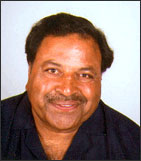
For more coaching information, visit www.coachshiv.com
| January | February | March |
|
April | May | June |
|  |
|||||
| July | August | September | October | November | December | |
![]()
INTRODUCTION
The focus of this month's coaching article is the skill of spinning in full circles, either clockwise or anti-clockwise, and its consequences, both positive and negative.
This topic is very much in vogue presently. We will discuss 3 types of spins, and use some example game situations from the 2008 Beijing Olympics to demonstrate them.
TYPES OF SPINS
Using the clock shown below to visualise, the 3 types of spins are as follows:
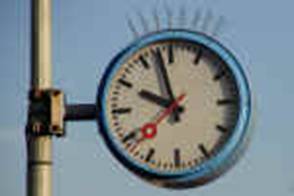
| Mini-Step Spin |
In a Mini-Step Spin scenario, the player does less than one quarter of a spin, by slightly opening his left or right foot, while always facing the attacking goal or player.
In such a situation, the ball is exposed, and there is a high risk of it being turned over. But at the same time, the big advantage is that the player with the ball has a clear view of the field, teammates, opponents and options. If the player with the ball has a high level of ball control (e.g., Manzoor Jr. of the 1980s Pakistani hockey team), the player will able to make a positive pass and play offensive hockey.
In the example screen shots below, the Australian half-back in green just slightly opens his right foot and sells a dummy to the Spanish forward, who shifts a yard or two to intercept the back pass. This generates ample space for the Australian half-back to make a accurate positive pass to his leading midfield player (centre-half).
| Scenario 1: Mini-Step Spin | |
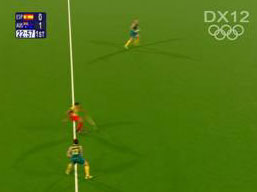 |
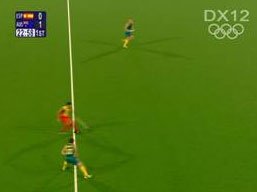 |
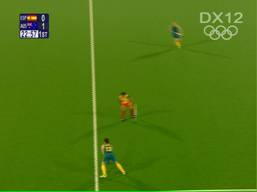 |
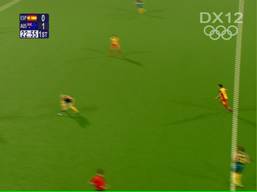 |
| 2008 Beijing Olympics semi-final, Australia vs. Spain | |
| Medium Spin |
In a Medium Spin scenario, the player makes a half turn to his left or right, and in this process, may turn his body sideways to his attacking goal or opponent.
The medium spin does help to protect the ball, and at the same time, allow a decent view of the field, teammates, opponents and options. Some situations would even require the player to make a back pass to maintain the possession, if the player is under a lot of pressure.
In the example screen shots below, the Australian right-half in green has controlled the ball very well to make a successful back pass to his right full-back, and change the focus of play.
Coaching Tip: The Australian right-half would have achieved the same objective if he had just opened his left foot and curled anti-clockwise to his left. The advantage of this latter option is a better offensive field view, wherein he is not turning his back to the opponent's goal. Just in case the Spanish forward did over-commit, the Australian right-half could have curled back to his right and made a positive attacking pass.
| Scenario 2: Medium Spin | |
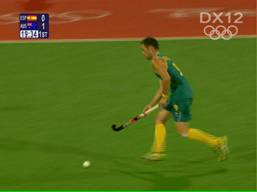 |
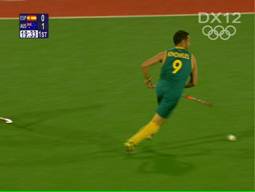 |
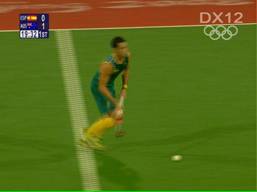 |
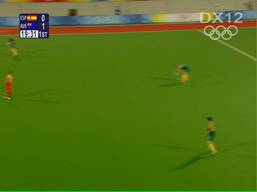 |
| 2008 Beijing Olympics semi-final, Australia vs. Spain | |
| Full-Circle Spin |
In a Full-Circle Spin scenario, the player spins a full circle either clockwise or anti-clockwise. It helps the player to protect the ball, but at the same time, turning his back to the attacking goal or opponent has limited his vision and view.
This is a very defensive move; in most cases, the player will not be able to make a forward pass, and sometime, even lose possession of the ball and commit a turnover.
In the example screen shots below, the attacking Chinese player # 8 in white tries to make a full-circle anti-clockwise spin on top of the German D, but ends up losing the ball. The reason for the turnover was that she was not aware of the position of the German defenders, since she had her back to them and the goal.
Coaching Tip: The Chinese player #8 was better off making a block-return-pass to her teammate in the far right, who had passed her the ball on a long corner. After doing that, she could have tried to get open, and be in a better position to receive a pass, while facing the attacking goal.
| Scenario 3: Full-Circle Spin | |
 |
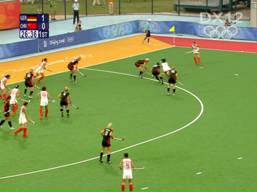 |
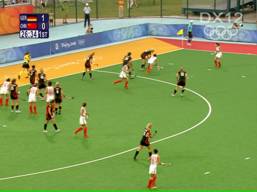 |
|
| 2008 Beijing Olympics semi-final, China vs. Germany (women) | |
CONCLUDING THOUGHTS
Should we teach the spin skill to young and upcoming players?
We should introduce the full spin skill to our young and upcoming players, but not over-emphasise it. The coaching focus should be more on the mini-step spins and medium spins. Investing time in these effective spin moves, along with footwork and ball control, will harvest rich dividends in the long run.
When is this skill effective and when is it not?
Spins are most effective in a defensive game situation, when the possession of the ball has to be maintained, under pressure.
Also, it is better to do the spin move in stages - stop, freeze and go; that makes it harder for the opponents to cope with the move. And it sure gives more space and time to the player with the ball.
Has there been a drop in the use of the full-circle spin by the players at the highest level?
Yes, there has been a drop in the use of the full-circle spins by top players in the past decade. This move is slowly being discarded. This is generally used in a defensive situation, when the possession of the ball has to be maintained, rather than in an offensive game situation.
The sad part is that the coaches at the school, college/university level in North America are still trying to teach this full spin skill to their student athletes, without realizing its negative impacts on the game. We as coaches and players have to be aware of what is good and what is not so good for our players, and educate them accordingly.
![]()